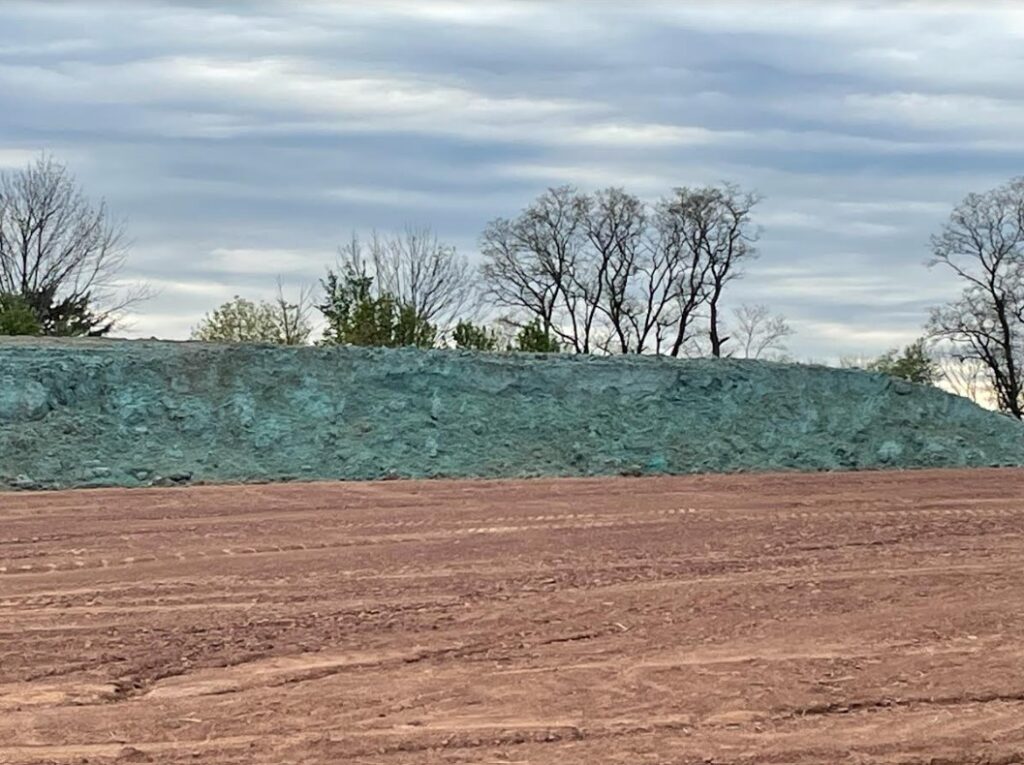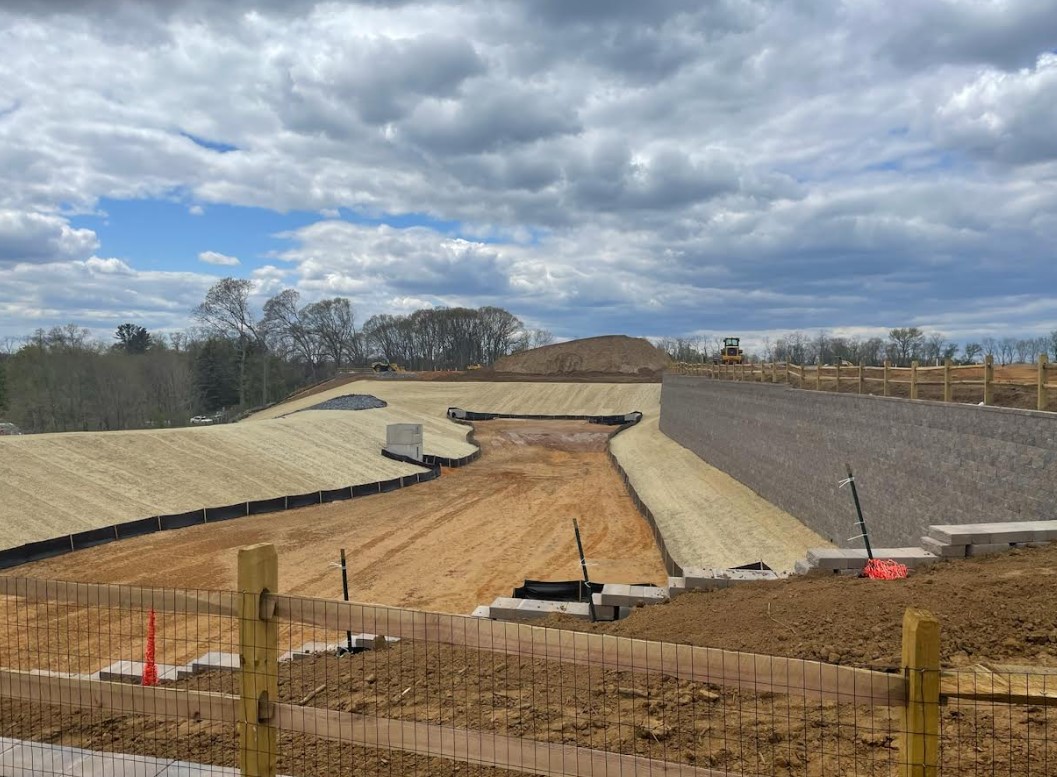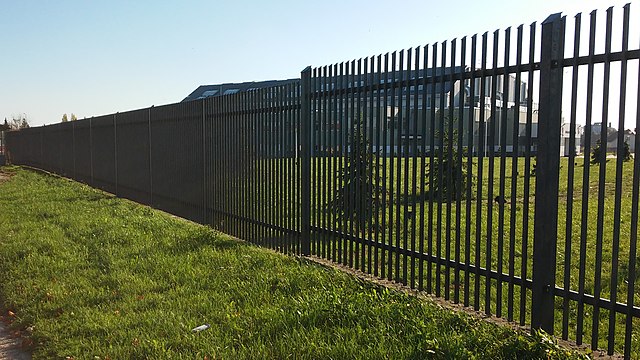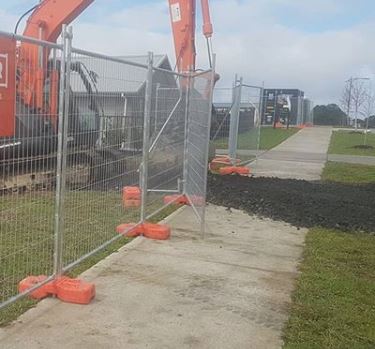
Soil stockpiles are an essential part of construction projects, as they provide the necessary material for grading and building structures. However, if not managed properly, these stockpiles can become a major source of erosion and sediment pollution.
Effective management of soil stockpiles is important to prevent negative impacts on the environment and comply with regulations. This includes proper planning, construction, and maintenance of stockpiles throughout the project.
Stockpile management is essential for erosion and sediment control in New Jersey construction. Let’s review best practices, regulations, and potential consequences of mismanagement.
Erosion and sediment control is the process of preventing or minimizing the movement of soil
Without effective erosion control, soil and sediment moves from construction sites into nearby water bodies. Proper stockpile management and slope stabilization are important erosion control measures.
The main goal of erosion and sediment control is to protect water quality by reducing the amount of pollutants that enter streams, lakes, and oceans. Pollutants from construction sites can include sediment, chemicals, and other contaminants that can harm aquatic life and ecosystems.
Proper erosion and sediment control is also important for ensuring the safety of workers on construction sites and preventing damage to surrounding infrastructure.
Also, by implementing erosion and sediment control measures, construction companies can avoid costly fines and delays due to non-compliance with regulations. When used properly, they protect the environment from the disturbance of construction projects.
Why is proper stockpile management important?
Stockpile management is an important part of erosion and sediment control, as poorly managed stockpiles can contribute significantly to sediment pollution. When soil stockpiles are not properly planned, constructed, or maintained, they can easily erode or be washed away by rainwater and wind.
This erosion can result in the release of large amounts of sediment, which can then be carried by stormwater runoff into nearby bodies of water. Sediment pollution has negative impacts, including reduced water quality, damage to aquatic habitats, and clogging pipes and drainage systems.
In addition to the environmental consequences, inadequate stockpile management can also lead to costly fines and delays for construction projects. Effective stockpile management can also reduce the need for additional material, saving construction companies time and money.
Construction companies should prioritize proper stockpile management in their erosion and sediment control plans. Here are the key considerations for managing soil stockpiles.
Management Considerations for soil stockpiles
Proper stockpile management involves careful planning, construction, and maintenance of soil stockpiles on construction sites. This includes considering factors such as size and location of the stockpile, access and drainage, and erosion control measures.
When planning the size of a stockpile, it is essential to consider the type of soil, the intended use, and any regulatory requirements. The location of the stockpile should also be chosen to minimize impacts on nearby water bodies and infrastructure.
Access and drainage are important for preventing erosion and ensuring worker safety. Stockpiles should have proper access points for equipment to enter and exit without causing damage, as well as proper drainage systems to prevent stormwater from accumulating and eroding the stockpile.
Additionally, implementing erosion control measures such as covering the stockpile with a hydroseeding or installing sediment barriers can greatly reduce the potential for sediment pollution. By carefully considering these management considerations, construction companies can effectively manage their soil stockpiles and protect the environment. So let’s explore some best practices for stockpile management.
Best practices for stockpile management
There are several best practices that construction companies can follow to ensure proper stockpile management for erosion and sediment control. These include:
- Planning ahead: Careful planning is essential to determine the appropriate size, location, and management considerations for a soil stockpile.
- Regular inspections: Routine inspections of the stockpile, access points, and drainage systems can help identify any issues that need to be addressed.
- Proper construction: Stockpiles should be constructed with a maximum height and a flat top and as long as the space allows. This allows the soil to breathe, maintaining life in the soil while providing stabilization to prevent erosion.
- Maintenance: Regular maintenance, such as covering the stockpile with erosion blankets or vegetative cover or removing excess sediment buildup, can greatly reduce the potential for pollution.
- Compliance with regulations: Construction companies should always comply with local, state, and federal regulations for stockpile management to avoid fines and delays.
- Monitoring: Monitoring the stockpile and surrounding areas for signs of erosion or sediment pollution can help catch issues early on and prevent further damage.
By following these best practices, construction companies can effectively manage their soil stockpiles and maintain compliance with regulations while protecting the environment.
Is proper stockpile management enough?

While proper stockpile management is a main component of erosion and sediment control, it alone is not enough to prevent all pollution from construction sites. Other best practices for erosion and sediment control include:
Implementing erosion control measures at the construction site, such as silt fences, sediment basins, and vegetative buffers. Using sustainable construction practices to minimize disturbance to the land and reduce the need for stockpiles. Properly disposing of excess soil and construction waste to prevent pollution. Regularly monitoring water quality in nearby water bodies to ensure no negative impacts from the construction site.
Also, educating construction workers about the importance of erosion and sediment control and proper stockpile management can help ensure that these practices are followed on-site. By combining proper stockpile management with other erosion and sediment control best practices, construction companies can effectively protect the environment and ensure the success of their projects.
Why Erosion and Sediment Control is essential for the environment
Erosion and sediment control practices, including proper stockpile management, is important for protecting the environment from harmful impacts of construction activities. Soil erosion can lead to significant amounts of sediment pollution, which can harm aquatic habitats, reduce water quality, and damage infrastructure.
Sediment pollution can also have long-term environmental consequences, such as altering the natural flow of streams and rivers and disrupting the balance of ecosystems.
By implementing erosion and sediment control measures, construction companies can reduce their impact on the environment and protect sensitive areas from pollution. This not only benefits local wildlife but also ensures the long-term sustainability of our water resources for future generations.
Plus, by prioritizing proper stockpile management and other erosion and sediment control practices, construction companies showcase their commitment to environmental stewardship. This can improve public perception of the industry and potentially attract more environmentally-conscious clients. Ultimately, effective erosion and sediment control is essential for both the environment and the success of construction projects.
Mistakes that can lead to improper stockpile management
There are some common mistakes that construction companies should avoid. These include:
- Improper location selection: Choosing a location without considering potential impacts on the environment or nearby infrastructure can lead to costly and harmful consequences.
- Lack of regular inspections: Without regular inspections, issues with erosion and sediment control can go unnoticed and escalate into significant problems.
- Inadequate construction: Failure to properly construct stockpiles or stabilize them with appropriate vegetative cover can result in erosion and sediment pollution.
- Neglecting maintenance: Failing to cover the stockpile during rain events or remove excess sediment buildup can lead to pollution and potential fines.
- Non-compliance with regulations: Not following local, state, and federal regulations for stockpile management can result in penalties and project delays.
By being aware of these mistakes, construction companies can take proactive measures to avoid them and ensure proper stockpile management. This not only protects the environment but also promotes a positive reputation for the company in the industry.
Does size matter when it comes to soil stockpiles?
The size of a soil stockpile can significantly impact the effectiveness of erosion and sediment control efforts. While smaller stockpiles may be easier to manage, they may not always be feasible due to project needs. However, larger stockpiles require more careful planning and management.
Larger stockpiles also have a higher potential for erosion and sediment pollution due to their size and weight. The soil may become too compacted and destroy the important beneficial microorganisms. When a large stockpile begins to smell rotten, this means it has become compacted and anaerobic. These conditions allow harmful bacteria to grow and overpopulate the stockpile. To mitigate these risks, construction companies should consider implementing additional measures, such as increased monitoring and maintenance.
Moreover, the amount of soil being stockpiled can also affect its quality over time. Stockpiling large amounts of soil for extended periods can result in compaction and nutrient loss, making it less suitable for use in construction projects.
Properly managing the size of soil stockpiles is important for both erosion and sediment control efforts and the quality of the soil itself. By finding a balance between project needs and environmental protection, construction companies can effectively manage their stockpiles and minimize their impact on the environment.
Tips for proper stockpile management
To ensure proper stockpile management and effective erosion and sediment control, here are some tips that construction companies should follow:
- Select a suitable location: Choose an area away from sensitive environmental features and infrastructure.
- Construct the stockpile correctly: Layering soil and stabilizing slopes can help prevent erosion.
- Regularly inspect and maintain: Regular inspections can identify issues early on, and proper maintenance can prevent pollution.
- Monitor water quality: Regularly testing nearby bodies of water for sediment pollution can indicate if erosion control measures are working effectively.
- Follow regulations: Ensure compliance with all applicable regulations for stockpile management.
By following these tips, construction companies can effectively manage their stockpiles and protect the environment from erosion and sediment pollution. Implementing these practices also showcases a commitment to environmental preservation, which is becoming increasingly important in the construction industry.
Effective stockpile management is important for both the environment and New Jersey construction projects
By avoiding common mistakes, managing the size of stockpiles, and following best practices, construction companies can ensure proper erosion and sediment control. This not only protects the environment but also promotes a positive image for the industry.
By taking proactive measures, construction companies can contribute to sustainable practices and showcase their commitment to environmental stewardship. Choose suitable locations, construct and maintain stockpiles correctly, monitor water quality, and comply with regulations for proper stockpile management.
Call 732-370-0291 or Contact Us for a New Jersey Stockpile Management Project Estimate
FAQs
Is it necessary to follow erosion and sediment control practices?
Yes, it is essential to follow these practices to protect the environment from pollution and uphold environmental regulations.
Can improper stockpile management lead to fines?
Yes, neglecting proper construction, maintenance, and compliance with regulations can result in penalties and fines for construction companies.
How can I determine the appropriate size for a soil stockpile?
The size of a soil stockpile should be determined based on project needs and the capacity of the chosen location to prevent erosion and sediment pollution.



